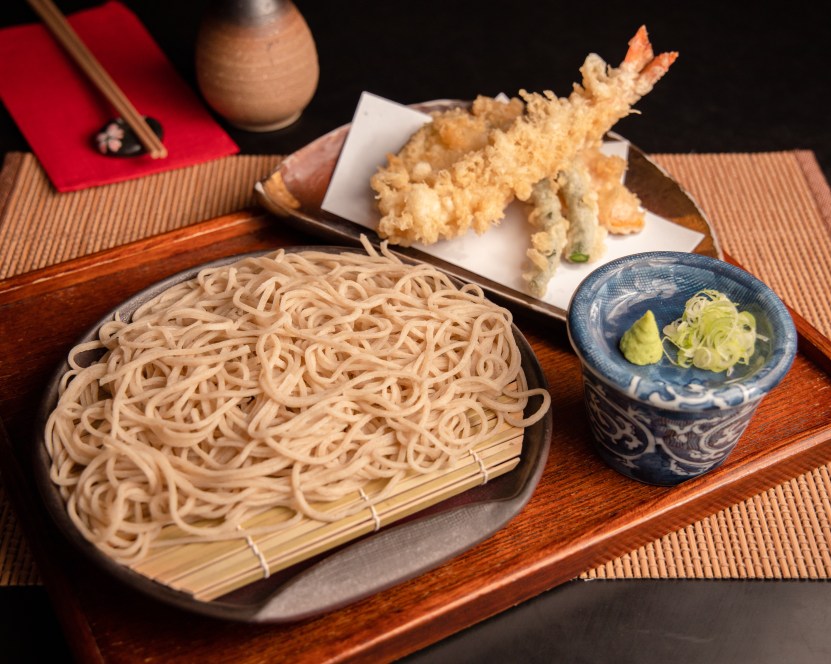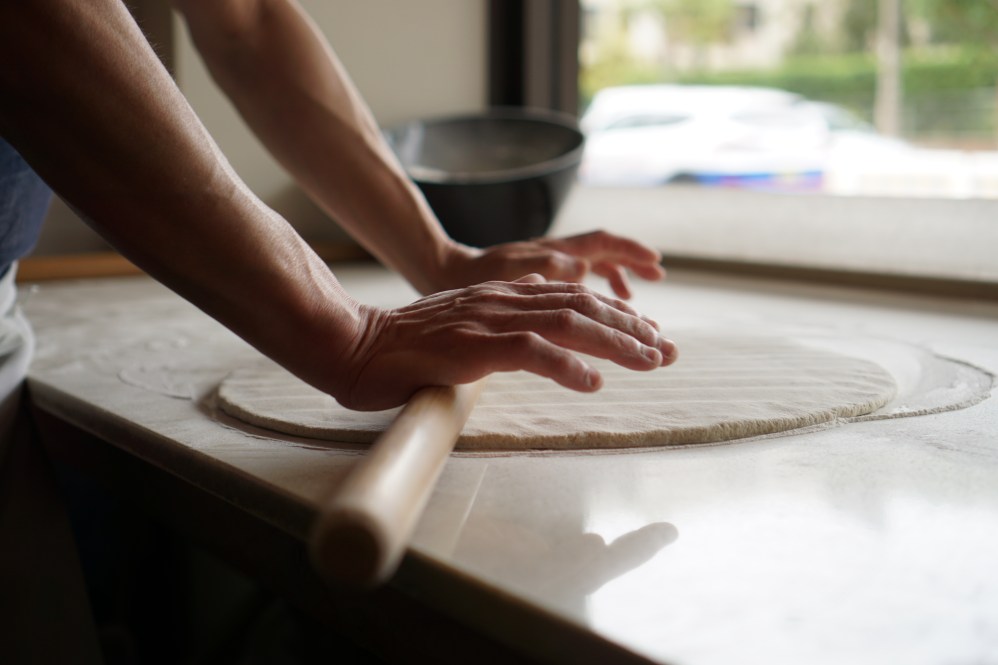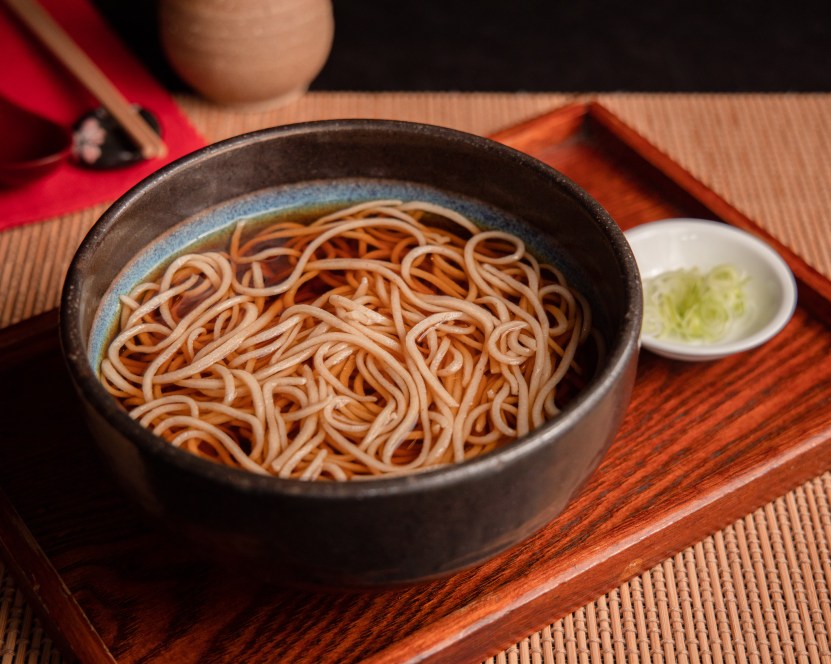Soba has been consumed in Japan since the Edo period. The buckwheat noodles are one of the original delivery foods, with soba couriers cycling piles of noodles to wealthy residents in the 1700s. Now, they are readily available dried or fresh, served hold or cold, with a dipping broth or in a soup — the choice is yours.
A serving of soba offers instant gratification to diners, which blurs the intense labour process required to make them. It’s a practice that’s hard to come by in Australia, but Chef Masahiko Tojo from Jugemu and Shimbashi in Sydney hasn’t wavered on making batches of soba from scratch for more than 20 years.
The chef talks to Hospitality about sourcing buckwheat from Tasmania, the three stages of soba-making and why it’s a technique he’s still mastering.
Masahiko Tojo first began making soba in 2000 at one of the original Shimbashi restaurants run by noodle master Yoshi Shibazaki, whose apprentices have gone on to open venues across Australia and abroad. “Yoshi has worked really hard to make soba well known here,” says Tojo.
“But it requires a lot of patience to get it right. It’s labour intensive and each batch takes around 30 minutes to make, so it’s a lot of work for a small number of noodles, but it’s worth the effort.”
At Jugemu and Shimbashi in Neutral Bay, soba is a key part of the menu, with Tojo making the noodles before each lunch and dinner service. The three-step process begins in the men-uchiba, a room at the front of the restaurant that has a stone grinder.

“We source all our buckwheat from a Tasmanian producer who has been growing it for Japanese soba restaurants for around 30 years,” says Tojo. “He has a special class of buckwheat, and we get the grouts to mill on-site at the restaurant. We mill every day before making the noodles, so we have the freshest-possible flour.”
The buckwheat is combined with Australian wheat flour according to an 85:15 ratio. “There are other methods that use 100 per cent buckwheat flour, but it’s a more fragile noodle,” says the chef. The final ingredient is water, but the amount added varies according to the weather and level of humidity at the time. “You come to learn when the dough is right,” says Tojo.
One of the unique aspects of soba dough is its toughness and the fact it doesn’t need to be rested before chefs can move on to rolling and cutting. “Mixing the dough takes about 10 minutes,” says Tojo. “It’s not left to rest like a bread dough. You can leave it if you need to, but you don’t want to expose it much to air — you want to get straight onto rolling, which is a complicated process.”
Want to read this story in print? Get Hospitality every month and subscribe to the magazine.
Three wooden rolling pins (noshibo) are needed for the next step: one is used for stretching and the others for maneuvering the dough. “You start out with a round
lump of dough which is laid out on a special soba board and end up with a symmetrical rectangle,” says Tojo.
“The dough ends up being much longer than the board, so you use the two pins to roll over the dough on one end and then you unroll, flatten, roll it up again and then go to the other end until you end up with a long rectangle shape.”
The flat dough is folded over for the cutting process, which necessitates a special knife — a soba-kiri bocho. This is no ordinary kitchen knife, though — it’s specifically crafted for cutting noodles.

A long oblong-shaped blade spans the length of a wooden handle, which has a space directly underneath it. “Cutting takes about five minutes,” says Tojo. “You move the knife along gently and keep the noodles nice and evenly spaced.”
Once the noodles have been cut, they’re stored in air-tight containers in the fridge and used for the next service. “You can’t expose them to air as they are delicate and don’t have any preservatives,” says Tojo. “We only use noodles that are made on the day, so they are always fresh.”
The production of soba is the most time-consuming aspect of making a noodle dish, with the cooking process taking place in less than 30 seconds. Jugemu’s kitchen is equipped with vats of water that are always on a rolling boil. “You’re looking for them to be on the firm side of al dente,” says Tojo. “After 30 seconds, the noodles are taken out and rinsed under cold running water until the starch is removed.”
There are two main culinary applications for soba noodles: one is in a hot soup and the other sees the noodles served on a zaru (bamboo plate) with tsuyu; a dipping sauce made with dashi, mirin and soy. “The real soba purists love to have it plain,” says Tojo.
“You really get the flavour of the buckwheat and the nutty, sweet aroma of the noodles with the plain broth or soup. The broth has more intensity than the soup, which you can drink to the bottom. But once you have finished the noodles, you can add the sobayu, which is the starchy water the noodles have been cooked in, to the broth and dilute it until it reaches a soup consistency.”

Jugemu’s soba menu covers everything from duck and mushroom broth to tempura options, but there’s also a bespoke offering for diners to try. “We have a walnut and sesame broth, which is quite unique,” says Tojo. “In Japan, duck is the most popular, but duck and mushroom is a combination I recommend.”
The chef also makes noodle specials from time to time, with green tea, earl grey or yuzu zest incorporated into the dough. “It just depends on how much time is available to do something extra,” he says.
In terms of accompaniments, soba is always served with spring onions, but tororo (puréed Japanese yam), grated daikon, natto (fermented soybeans) shredded nori and sliced okra are also popular additions to their respective dishes.
Tojo is the only chef in Sydney who specialises in making soba noodles, and he continues to hone his craft even after so much time has passed. “It looks easy, but it’s really difficult,” he says. “I am still perfecting it every day even after 20 years.”
Sponsored Content

Discover Dairy Farmers’ range of shredded cheese
Sponsored by Bega

Beachfront Melbourne Club catering & restaurant opportunity
Sponsored by Future Food
Trending Now
Resources
Lorem ipsum dolor sit amet, consectetur adipiscing elit. Fusce ac ornare lectus. Sed bibendum lobortis...
Lorem ipsum dolor sit amet, consectetur adipiscing elit. Fusce ac ornare lectus. Sed bibendum lobortis...
Sign up for our newsletter
